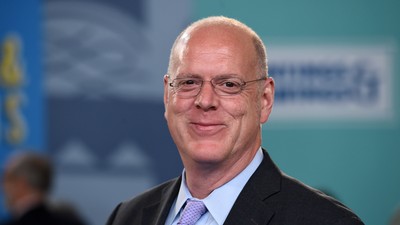Jean Lurçat "Gobi" Tapestry, ca. 1950
 Watch
Watch
GUEST:
I came by it through my parents, and they're gone. So it went to my sister, she's gone. So I have it now. (chuckles)
APPRAISER:
And do you know where they, they acquired it?
GUEST:
My parents were traveling in Europe right after World War II. I think he had business over there, and they came upon this in France.
APPRAISER:
Mm-hmm.
GUEST:
And brought it back, that was maybe the late '40s.
APPRAISER:
And do you know where in France they acquired it?
GUEST:
I heard it was from Aubusson.
APPRAISER:
Mm-hmm.
GUEST:
Where they used to make the old tapestries.
APPRAISER:
It is from Aubusson. It is a tapestry from the mid-20th century. I would put a date 1945 to 1950 on it. The cartoon, which is the design of the tapestry, was done by a gentleman named Jean Lurçat, who is, without a doubt, the premier tapestry designer in France, of mid-20th-century France.
GUEST:
Ooh La, la! (chuckles)
APPRAISER:
He is also a painter, also was a carpet designer, but he's really best known for his tapestry designs, his cartoons, and he really was one of the driving artists behind the revitalization of the Aubusson tapestry looms in the mid-20th century, after the war, to make these very modern, fantastic pieces. It's a handwoven tapestry weave. They still had trained artisans in the town of Aubusson. This particular piece, while designed by Lurçat, was made and woven by a company called Pinton Brothers, which was one of the leading Aubusson workshops in the mid-20th century. Lurçat, his signature's here in the bottom corner, but next to it is a "P.F.," which is Pinton Frères, which is Pinton Brothers. The name of this tapestry is "Gobi." It's inspired by a night scene in the Gobi Desert in China.
GUEST:
You mean, you recognize it!
APPRAISER:
Which is why you have kind of bamboo-looking...
GUEST:
Yeah.
APPRAISER:
…motifs through the tapestry, and these blue dots that are kind of hinting at stars as a night scene. By the modernism of the mid-20th century, everything was highly stylized. They were suggestions of ideas, as opposed to really naturalistic depictions. I know a lot about Lurçat, I know a lot about Lurçat tapestries.
GUEST:
You do, hey.
APPRAISER:
This is one of the greatest ones I've ever seen.
GUEST:
(gasps) Really?
APPRAISER:
Lurçat tapestries can tend to be quite busy, a little too much going on. This has a cleanness to it that is really, to me, the best of mid-20th century French tapestry.
GUEST:
Yeah, it's...
APPRAISER:
Do you have any idea of value?
GUEST:
Well, I was thinking maybe, uh, $5,000.
APPRAISER:
The retail value is $15,000, because it's really quite a remarkable tapestry.
GUEST:
Whoa.
Appraisal Details

Executive producer Marsha Bemko shares her tips for getting the most out of ANTIQUES ROADSHOW.
Value can change: The value of an item is dependent upon many things, including the condition of the object itself, trends in the market for that kind of object, and the location where the item will be sold. These are just some of the reasons why the answer to the question "What's it worth?" is so often "It depends."
Note the date: Take note of the date the appraisal was recorded. This information appears in the upper left corner of the page, with the label "Appraised On." Values change over time according to market forces, so the current value of the item could be higher, lower, or the same as when our expert first appraised it.
Context is key: Listen carefully. Most of our experts will give appraisal values in context. For example, you'll often hear them say what an item is worth "at auction," or "retail," or "for insurance purposes" (replacement value). Retail prices are different from wholesale prices. Often an auctioneer will talk about what she knows best: the auction market. A shop owner will usually talk about what he knows best: the retail price he'd place on the object in his shop. And though there are no hard and fast rules, an object's auction price can often be half its retail value; yet for other objects, an auction price could be higher than retail. As a rule, however, retail and insurance/replacement values are about the same.
Verbal approximations: The values given by the experts on ANTIQUES ROADSHOW are considered "verbal approximations of value." Technically, an "appraisal" is a legal document, generally for insurance purposes, written by a qualified expert and paid for by the owner of the item. An appraisal usually involves an extensive amount of research to establish authenticity, provenance, composition, method of construction, and other important attributes of a particular object.
Opinion of value: As with all appraisals, the verbal approximations of value given at ROADSHOW events are our experts' opinions formed from their knowledge of antiques and collectibles, market trends, and other factors. Although our valuations are based on research and experience, opinions can, and sometimes do, vary among experts.
Appraiser affiliations: Finally, the affiliation of the appraiser may have changed since the appraisal was recorded. To see current contact information for an appraiser in the ROADSHOW Archive, click on the link below the appraiser's picture. Our Appraiser Index also contains a complete list of active ROADSHOW appraisers and their contact details and biographies.













